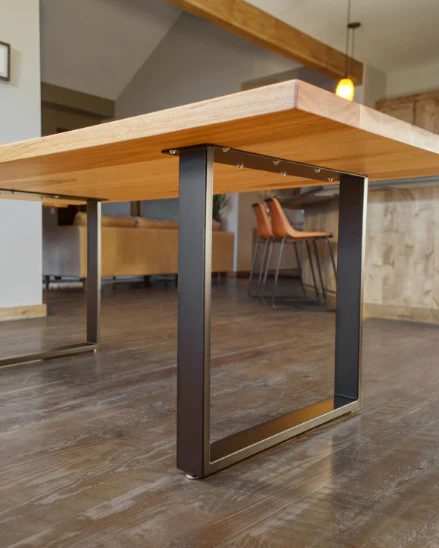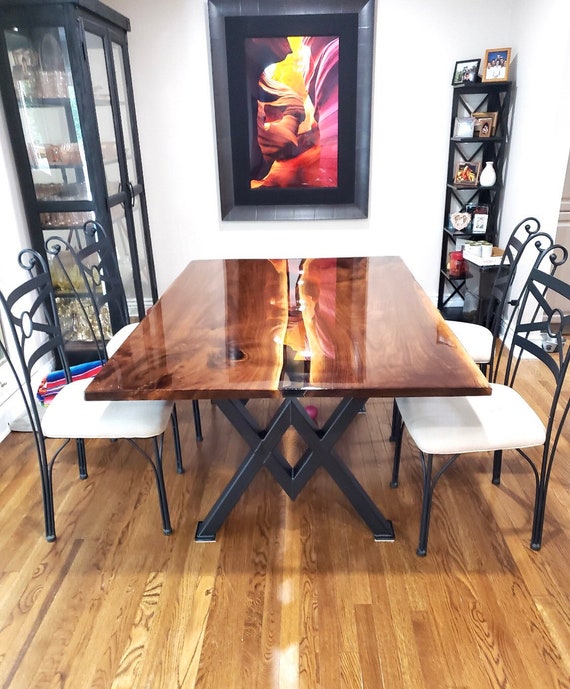From Standard to Modern: Locate the Suitable Dining-room Table Legs for Your Style
The selection of dining space table legs plays a critical role in specifying the overall personality of your area, bridging the gap in between standard craftsmanship and modern-day visual appeals. While classic layouts such as cabriole and turned legs stimulate a sense of ageless class, contemporary styles like barrette and geometric choices provide a possibility for striking visual passion. Examining the ideal balance in between these styles needs a nuanced understanding of your existing decoration and individual taste. As you take into consideration these aspects, the inquiry remains: exactly how can you perfectly incorporate these varied leg designs to develop a harmonious eating experience?
Comprehending Table Leg Styles
The range of eating space table leg designs can significantly influence both the looks and capability of the space. Each leg style contributes special practical features and aesthetic components, satisfying diverse design preferences and use needs. Recognizing these styles is essential for selecting the right dining table that straightens with your overall interior decoration vision.
For example, conical legs offer a clean, traditional look that can enhance a space's style, while stand bases supply stability and make the most of legroom, making them optimal for smaller spaces. Barrette legs, a trademark of mid-century contemporary layout, introduce an industrial panache, permitting for a ventilated, open feeling. Trestle legs evoke rustic beauty, supplying durable support and a feeling of timelessness.
Wood legs can bring warmth and structure, whereas steel options usually communicate a streamlined, contemporary vibe. Inevitably, comprehending table leg styles is important for producing a natural dining area that shows individual design while making certain usefulness and convenience.
Typical Table Leg Options
When selecting dining-room table legs, conventional alternatives often embody ageless style and workmanship. These layouts mirror an abundant heritage and a commitment to top quality, making them ideal for those who appreciate traditional aesthetics.
Among one of the most legendary traditional leg styles is the cabriole leg, characterized by its stylish rounded form. This style usually includes attractive carvings and is most commonly found in Queen Anne and Chippendale furniture. Another preferred option is the turned leg, which boasts a collection of smooth, rounded forms that supply a classic look while preserving stability.
Additionally, the straight leg, while simple, uses a tough and basic framework that can blend effortlessly with a range of tabletop designs. For those drawn to ornate describing, claw-and-ball feet legs stimulate a feeling of majesty and can act as a sensational focal factor in any kind of dining space.
Lastly, stand bases, although not strictly legs, supply an alternate standard option that permits ample legroom and can be magnificently carved. Each of these conventional leg styles adds to the overall atmosphere of a dining room, weding feature with aesthetic allure.

Modern Table Leg Styles
Modern table leg designs supply a varied series of designs that highlight clean lines and cutting-edge products. These layouts commonly prioritize capability while working as striking prime focus within a dining room. Minimalist appearances are widespread, with legs crafted from materials such as steel, glass, and crafted wood, which add to a contemporary and ventilated feel.
One popular layout is the hairpin leg, identified by its slender, conical framework that supplies from this source stability without overwhelming the table top (dining room table legs). This style is usually found in mid-century contemporary furnishings and can easily complement different eating table shapes. An additional fad is the use of geometric shapes, where legs might take on unbalanced or angular forms, adding aesthetic passion and a touch of artistry

Mixing Designs for Special Areas
Usually, home owners look for to develop special dining spaces that reflect their personal design by blending various design components. This strategy permits for the unification of varied aesthetics, causing an unified yet unique environment. Combining a rustic wood table with sleek, modern-day steel legs can produce an appealing contrast that elevates the area's general appeal.
In addition, integrating vintage table legs with modern table tops can evoke a feeling of history while keeping a contemporary sensibility. Such mixes not only display private preference however additionally encourage creativity, permitting property owners to curate a space that feels both individual and welcoming.
Shade plays a vital role in this mixing procedure; choosing table legs that enhance or comparison with the existing color pattern can boost aesthetic interest. As an example, whitewashed legs can soften the boldness of a dark table surface area, creating a balanced aesthetic.
Tips for Picking the Right Legs
Picking the right table legs is crucial for attaining both performance and visual allure in your dining area. Begin by considering the total style of your space. Typical settings gain from legs that include detailed carvings or turned styles, while modern spaces may call for smooth, minimal designs.
Following, assess the height and security of the legs. dining room table legs. Basic table why not check here vary in between 28 to 30 inches in elevation, so make sure the legs enhance this measurement for comfort. Additionally, robust materials, such find more information as wood or metal, can enhance stability and long life
Review the leg form as well-- choices consist of right, tapered, or stand layouts. Straight legs supply a classic look, while tapered legs can add a touch of beauty. Pedestal bases supply adequate legroom and are ideal for smaller sized rooms.
Conclusion
In summary, choosing the excellent eating room table legs requires careful factor to consider of both traditional and modern styles. Typical alternatives such as cabriole and transformed legs use ageless beauty, while modern designs like hairpin and geometric shapes provide a modern touch. By balancing leg style, height, and product with the total decor, a natural and welcoming environment can be accomplished. Ultimately, the picked table legs must mirror the preferred aesthetic, boosting the eating experience within the space.
The variety of eating space table leg styles can significantly affect both the aesthetics and capability of the area. Ultimately, recognizing table leg styles is important for developing a cohesive eating area that mirrors personal design while ensuring functionality and comfort.One of the most legendary conventional leg designs is the cabriole leg, characterized by its stylish bent shape. Straight legs offer a traditional appearance, while tapered legs can include a touch of style.In summary, picking the suitable eating room table legs needs mindful consideration of both traditional and contemporary styles.
Comments on “How Dining Room Table Legs Can Change the Entire Aesthetic of Your Room”